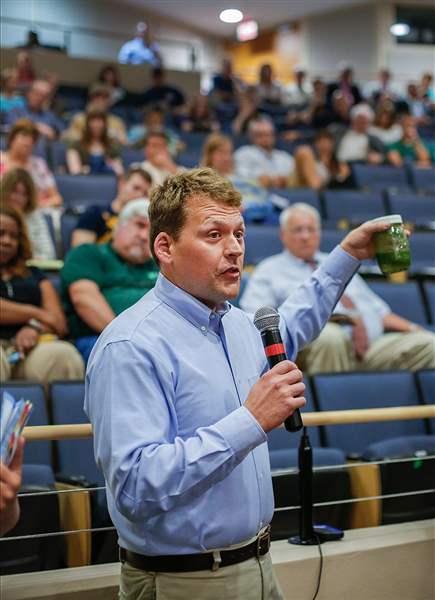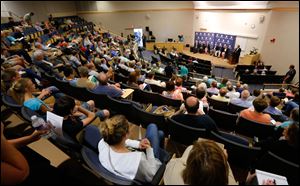
Speakers at UT forum call crisis turning point
8/6/2014
Lyman Welch of the Alliance for the Great Lakes holds up a sample of Lake Erie water during the forum at UT.
THE BLADE/ANDY MORRISON
Buy This Image

More than 200 people attended a six-member panel discussion that the University of Toledo quickly put together. The forum was in response to the unprecedented event that sent 500,000 metro Toledo residents scrambling for bottled water.
Last weekend’s algae-induced water crisis needs to become as much of a galvanizing moment for the Great Lakes region as the release of Rachel Carson’s landmark 1962 book, Silent Spring, and the 1969 Cuyahoga River fire, one of the University of Toledo’s top Lake Erie researchers said on Tuesday.
“We know what the cause is. It is time to mobilize and act,” Carol Stepien, UT distinguished professor of ecology and the director of UT’s Lake Erie Research Center in Oregon, told the crowd. More than 200 people attended a six-member panel discussion that the university quickly put together. The forum was in response to the unprecedented event that sent 500,000 metro Toledo residents scrambling for bottled water.
PHOTO GALLERY: Algae forum at University of Toledo
RELATED ARTICLES:
Mayor calls for water to be conserved for rest of summer
Water bottles overflow recycle bins.
Companies pitch in during water crisis.

Lyman Welch of the Alliance for the Great Lakes holds up a sample of Lake Erie water during the forum at UT.
High levels of toxic microcystis triggered a public health emergency when it rendered the city’s tap water undrinkable for three days.
Microcystis is a form of blue-green algae that has fouled western Lake Erie almost annually for the last 19 years, yet never had become so concentrated near Toledo’s intake crib that it overpowered the city’s Collins Park Water Treatment Plant.
Even 45 years after its release, Ms. Carson’s book is hailed by many and scorned by others globally because of the links it made between human exposure to pesticides, especially DDT, and cancer. It is often referred to as the start of the modern environmental movement, and many Great Lakes scientists have said it led to a fundamental shift in how public health issues are investigated.
Few people know the Cuyahoga River was actually one of four Great Lakes tributaries so polluted with oil and filth in the years leading up to the 1972 Clean Water Act that they caught fire. And the Cuyahoga was ablaze multiple times. But it is best known for a 1969 fire that symbolized the need for stronger Great Lakes protection, a galvanizing point on the eve of the first Earth Day in 1970, which resulted in the modern era of sewage controls.
“I think the one thing we have to keep in mind is this is a large-scale regional problem,” said Patrick Lawrence, UT professor and chairman of geography and planning, citing agricultural runoff and sewage spills as far away as Fort Wayne, Ind., contributing to western Lake Erie’s algae.
The Maumee River, which starts in Fort Wayne and flows into the lake in Toledo, is one of the Great Lakes region’s largest and most important tributaries, but also one of the most heavily impacted by runoff from farms and concentrated animal feeding operations, or CAFOs, speakers said.
“Land management practices on farmland are improving. But we still need to do a lot of work,” Mr. Lawrence said. He later said it’s “up to us to put pressure” on lawmakers to see that the watersheds flowing into Lake Erie are better protected.
Coincidentally, about the same time speakers at the UT event described the Toledo water crisis as a turning point, stories were distributed that said Chicago Mayor Rahm Emanuel was calling for a Great Lakes summit of mayors to discuss ways they could help prevent a recurrence.
Dr. Thomas Sodeman, professor of medicine and chief of gastroenterology at the UT College of Medicine and Life Sciences, described how the toxin in microcystis, called microcystin, attacks the liver. Laboratory mice injected with it die within a short time. Pets and livestock that gain access to it from ponds have succumbed to it, he said.
“Dogs eat dried algae at the side of a lake. They’ll eat this stuff in large quantities and die,” Dr. Sodeman, a liver expert, said.
One person in the audience, Lyman Welch, water quality program director for the Great Lakes region’s largest environmental group — the Alliance for the Great Lakes of Chicago — described the Toledo water crisis as an event “crying out to the city and the nation for action.”
“The solutions are there for us to seize,” Mr. Welch said. “This water is in distress.”
Contact Tom Henry at: thenry@theblade.com or 419-724-6079.